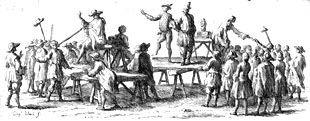
City as Theatre
Piranesi’s melancholic views of the city embody the essence of tragedy for in them he mourns the passing of a great civilization, his ideal of Rome being represented most poetically in ruins. By contrast, Vasi’s prints can be said to capture something of the enjoyment of everyday life of the city, not as it should be, nor even as it was, but as it exists at the moment. In his Five Books of Architecture (1537-1551), Sebastiano Serlio (1475 - 1554) articulates a theory of stage design which can serve as a convenient reference for discussing Vasi’s views of the city and its theatrical aspects. Serlio recommends three types of stage sets each modeled on classical theory as articulated by Aristotle in his Poetics. He represents the tragic stage set as a formal street of classically inspired palaces and monuments which exhibit the solemnity and decorum proper for nobles and noble deeds. The comic set, by contrast, is rather more of a hodgepodge of buildings loosely lining the street, with incongruous extremes such as a chapel in the background and a bordello in the foreground. Serlio informs us that the tragic stage set represents the best and that its protagonists are heads of state and great personages. Its characters are subject to the forces of destiny and their actions affect us all. The comic set portrays the typical or commonplace, and represents its characters as the playthings of chance. The third, the pastoral or satyric set, rounds out the triad, represented as a bucolic scene, with simple rustic huts populated with peasants, shepherds, nymphs and woodland creatures who obey not the laws of society but those of nature.
It is instructive to see how Vasi uses these themes in his depiction of the city in both its urban center and ex-urban periphery. It is possible to interpret his views as illustrated stage sets which depict the special character of places in the city and he does so with a stage director’s eye for both drama and dramatis personae. The street life of the city adds an important dimension to his work and typically enhances our knowledge about the parts of the city he represents and how they functioned. For example he depicts boisterous markets such as the Campo dei Fiori and the Portico d’Ottavio as swarming with shoppers and shopkeepers. The river ports are teeming with boats and workers while the major basilicas have pilgrims, clergy and the ubiquitous beggar in the forefront of the scene. Nobles alighting from carriages attended by footmen figure prominently in front of palaces and horseguards go through their maneuvers before the scuderie (stables) in the Piazza Monte di Cavallo. Bucolic landscapes outside the city or in the disabitato portray simple rustic shelters and are populated with shepherds and goatherds. Each seems to be a scene from a theatrical production inspired by Serlio and Vasi effectively uses these props to evoke the character place. The careful observer of his prints will also notice Rome’s netherworld of thieves, prostitutes, and beggars intermingled with the wealthy, who, while blissfully enjoying the spectacle of life during their Grand Tour, seem oblivious to this less glorious truth of 18th Rome.
|

